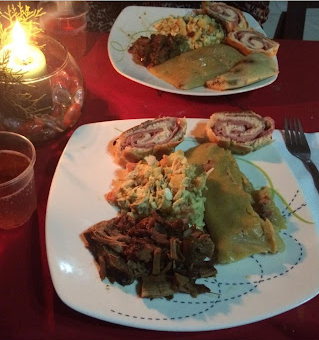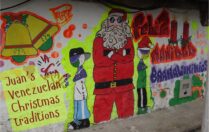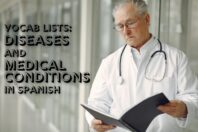A very Venezuelan Christmas: A personal perspective

Get our free email course, Shortcut to Conversational.
Have conversations faster, understand people when they speak fast, and other tested tips to learn faster.
More infoLast week we gave you one of our standard posts for the holiday season, teaching Spanish Christmas vocabulary. This week we decided to hand the blog over to one of our Spanish teachers here at BaseLang, asking her to share her family’s Venezuelan Christmas traditions. Let’s hear how Estefany and her family celebrate the holiday season in Venezuela!
I truly believe that there is nothing like Christmas. The family, the food, the decorations and the joyful and merry atmosphere are just what I look forward to every year. Out there, there are many ways to celebrate Christmas, countless traditions and customs that vary depending on location, cultural background, and on each family. In this opportunity, I want to share with you a piece of my own Christmas traditions and show you how my family and I celebrate our favorite date of the year as Venezuelans.
A Bit of Festive Background
Christmas is definitely one of the most important holidays for Venezuelans. As a country with a strong Catholic background, many of the traditions are closely linked to this religious heritage. And for many families, including my own, Christmas is a unique time to reunite as a family. A lot of my dearest family members only come to see us at Christmas, which makes this season even more special for me.
The Christmas Decorations
Growing up I was always fascinated by Christmas decorations, especially the lights. When the city was decorated, we used to drive around to see how the squares, lampposts and rivers were lit with lights of all shapes, sizes and colors.
At home, the decorating process starts in November. Every year we all have to wake up very early to clean the house thoroughly and then the grown-ups are responsible for retouching the paint on the walls if necessary. The next day the real decoration begins. The first step is to put up the tree. Since pine trees are not very common in Venezuela, families usually use plastic Christmas trees that last so many years that they become family heirlooms. After setting it up and stretching the branches, we must choose what ornaments will go on the tree. The garlands and balls on the tree are usually a mix of different sized and colored pieces accumulated over the years. Sometimes we use only ornaments of a specific color, such as red and gold or silver and blue. It all depends on the mood, really. Then we put the lights on the tree and a star ornament on the top.
When we finish with the tree, we continue with the nativity scene. In Venezuela we call it “pesebre”, meaning “manger”, the place where Jesus was born. My grandmother likes to collect nativity figures, so we have figures of all sizes. Some years we put a small scene under the tree and others we put a big one with a bunch of sheep made of plush or cotton. To make the nativity scene we use textured green paper, which is sold everywhere in December, to simulate a mountainous landscape. We also add moss and sticks to create a more rustic atmosphere. My personal favorite part is to put small ceramic houses around the nativity scene to give the feeling of a small rural village. Then, of course, we add figures of Baby Jesus, Virgin Mary, Joseph, the mule, the ox, the three Wise Men and some farmers and shepherds. When everything is ready, Baby Jesus is covered with a piece of cloth or cotton until he is born on Christmas.
My grandmother can sew very well, so every year she makes stuffed animals like reindeer and sheep to put around the house on tables and shelves. She also makes cushions with festive patterns to decorate the couch. To add more color to the house, we also put green and red tablecloths and towels. The finishing touch is always the lights, which we hang in the windows and on the curtains to make sure everything is lit up and Christmassy.
The Beginning of Christmas
Since my family is Catholic, we start preparing for Christmas from the first Sunday of Advent. We put up a wreath with four candles that are lit every week, until the week before Christmas all the candles are lit.
Between the 16th and 24th of December we celebrate the “aguinaldo masses.” Normally, we go to the first and the last mass. These masses are held very early, at 5 a.m.! But they are very joyful with carols and “aguinaldos,” a kind of lively Venezuelan Christmas music that gives the mass its name. After mass, everyone skates and bikes through the streets until it’s time to go home and have breakfast.
The Christmas Dishes
Christmas food is my absolute favorite thing. The traditional Venezuelan Christmas dish is composed of “hallaca,” “pan de jamón,” “ensalada de gallina” and “pernil.” I have no words to describe how delicious the combination of all these is.
The hallaca is a dish similar to a tamale. It is made of corn flour and is filled with meat, olives, capers, raisins, onions and peppers. It is then folded and wrapped in plantain leaves that are tied with string, and finally cooked in boiling water. Besides being absolutely delicious, the actual making of the hallaca is also a tradition. Every year, my family gets together to prepare about a hundred hallacas for Christmas, and it’s a team effort. Someone is responsible for preparing the stew, another for the dough, another for assembling the dish, another for oiling the leaves, and another one for tying the strings. It has always seemed to me that there is a certain hierarchy of age in the process: the youngest ones tie the hallacas until someone else replaces them, and now it’s up to them to take the next step up the ladder. Making hallacas can be exhausting. The hallacas are not only for us, but also for sharing with neighbors and friends. However, the process is a unique family moment filled with laughter, music and a tiny bit of alcohol.
Pan de jamón, literally ham bread, is a bread stuffed with ham, raisins and olives, which serves as a bread accompaniment. For as long as I can remember, we have bought our pan de jamón at the same bakery and it has never failed to be exquisite. Pernil is a marinated and baked piece of pork leg that serves as the main protein of the Christmas dish. The ensalada de gallina, meaning hen salad, is a very simple, but delicious recipe: carrots, potatoes, chicken and dressing.
In addition to the food, we also drink “ponche crema,” a typical alcoholic drink made with sugar and milk. It is very sweet and delicious. Sometimes we prepare a homemade version with flan and rum. We also make a non-alcoholic version for the children to enjoy.
Our Christmas Music
Venezuelan Christmas music is very joyful, although it has many nuances. Christmas carols and “aguinaldos” often have themes concerning the birth of Jesus and the gathering of families. On the other hand, “gaitas,” a type of folk music born in the state of Zulia, is often associated with Christmas, and is played a lot during this time of year. However, in addition to Christmas themes, this genre also addresses romantic, social and political themes. Either way, we dance to all of them, and they are an important part of our Christmas celebrations.
In Venezuela, the main celebration takes place on 24 December, on Christmas Eve. Traditionally, on that day we wear what we call “estrenos,” brand-new clothes specifically bought to look our best for the occasion.
The atmosphere is very cheerful and we all dance and sing to carols, aguinaldos and gaitas, and take photographs. My family is not too fond of fireworks, but we have fun watching our neighbors carrying sparklers, and shooting fireworks.
At about 11 o’clock we gather to pray in preparation for the birth of Jesus. Then we start to lay the table so that the dishes are ready to be served when the clock strikes twelve. We always put out the Christmas dishware and our best crystal glasses to give the dinner that special touch.
It’s Christmas Time!
When the time comes, the Baby Jesus figure from the nativity scene is uncovered to symbolize his birth, and everyone exchanges hugs to wish one another a Merry Christmas. Afterwards, it’s time for the long-awaited dinner. Before we begin to eat, we say a brief gratitude prayer and each of the guests shares something for which he or she is thankful. This rite is usually quite short, since by that time we are all really hungry and our mouths water from the smell of the food.
After we’re done with dinner, it’s time to open the gifts that Baby Jesus brought us all! That’s right, in Venezuela it is Baby Jesus who brings the presents and not Santa Claus. Now, it’s not that children don’t believe in Santa, but they believe that Latin America is Baby Jesus’s domain of work. After the gifts are opened, it is usually quite late. Those who are more tired go to bed while those who want to have a little more fun stay up chatting and drinking ponche crema.
Christmas day is pretty quiet: we eat the leftovers from dinner and go out to visit the neighbors to bring them hallacas and wish them a Merry Christmas. We also call relatives who couldn’t be with us. In this way, we make sure that all our loved ones share in one way or another a family Christmas with us.
Conclusion
Today I got to share with you a snapshot of my Venezuelan Christmas traditions. From the decorations, religious customs, food, music and gifts, Christmas in my home has always been synonymous with union, celebration and joy.
I think the most important thing about these traditions is being able to share them with others. Although there are very similar aspects of Christmas that we share universally, such as the decorations, there are other unique aspects that vary, such as the music and the food. I would really love to share hallacas and ponche crema with you all so you can see what I am talking about. Trust me, you wouldn’t regret it!
I hope you enjoyed this recounting of my Christmas traditions, and if one in particular caught your attention, give it a try, like skating after mass and drinking hot cocoa! That’s one of my favorites.
Regardless of where you are from or what holiday you celebrate, I wish you the best of holidays, surrounded by your family. ¡Feliz Navidad a todos! – Merry Christmas, everyone!







